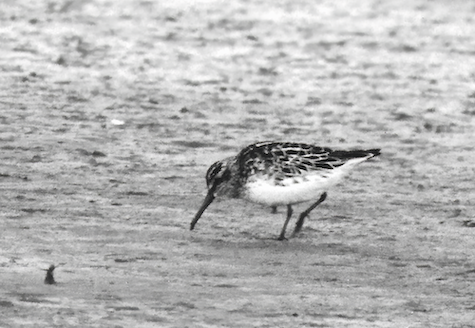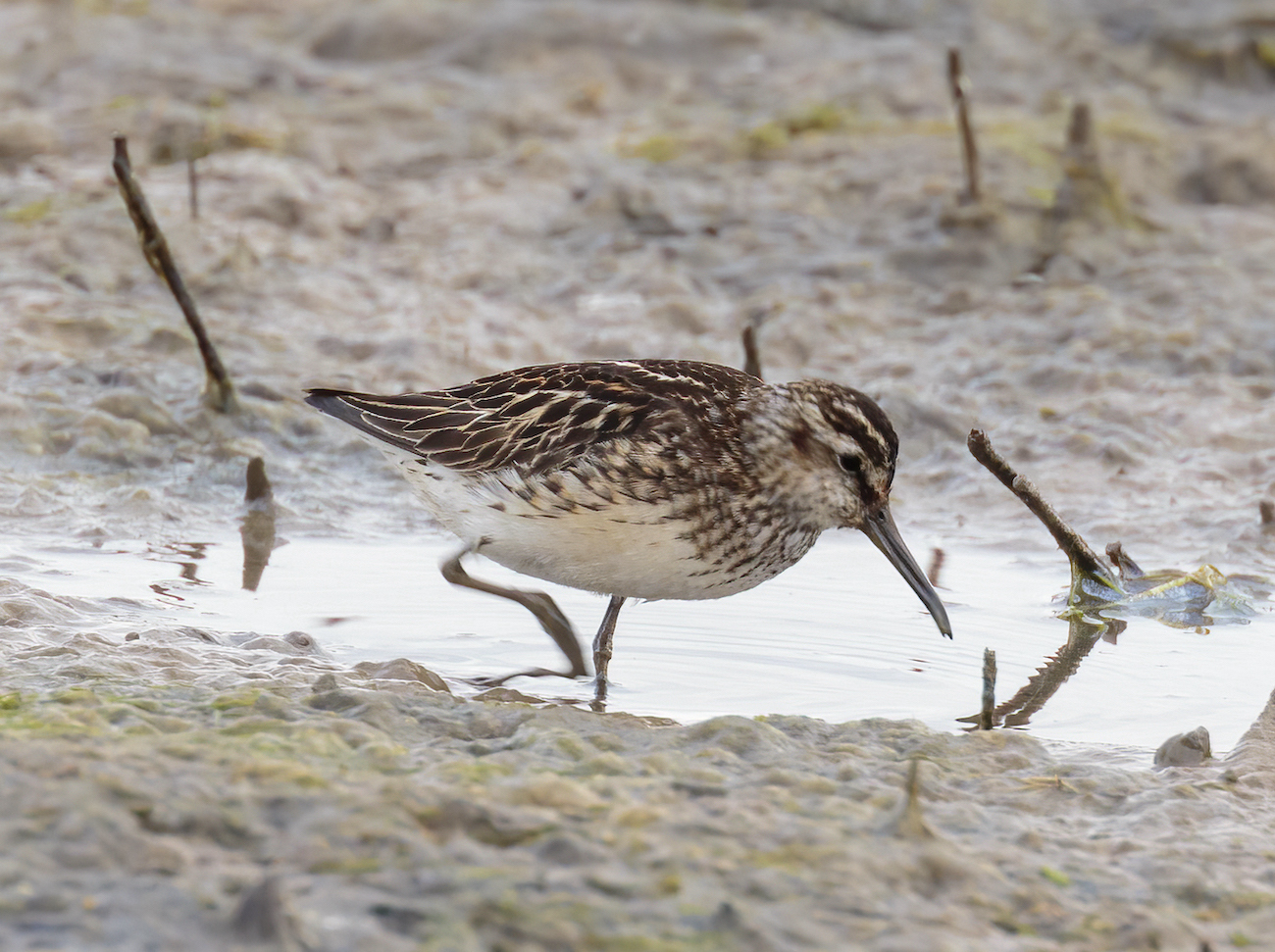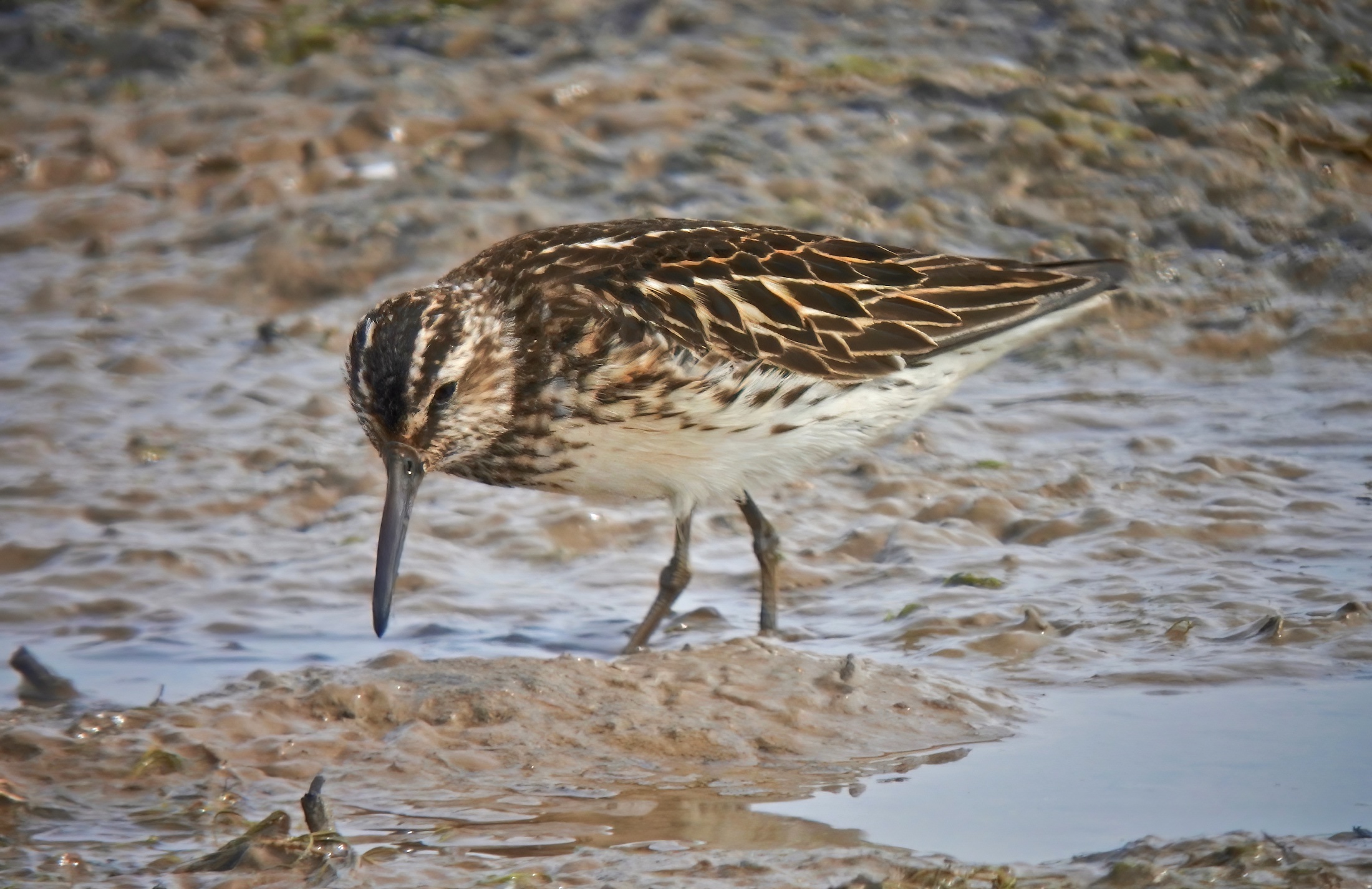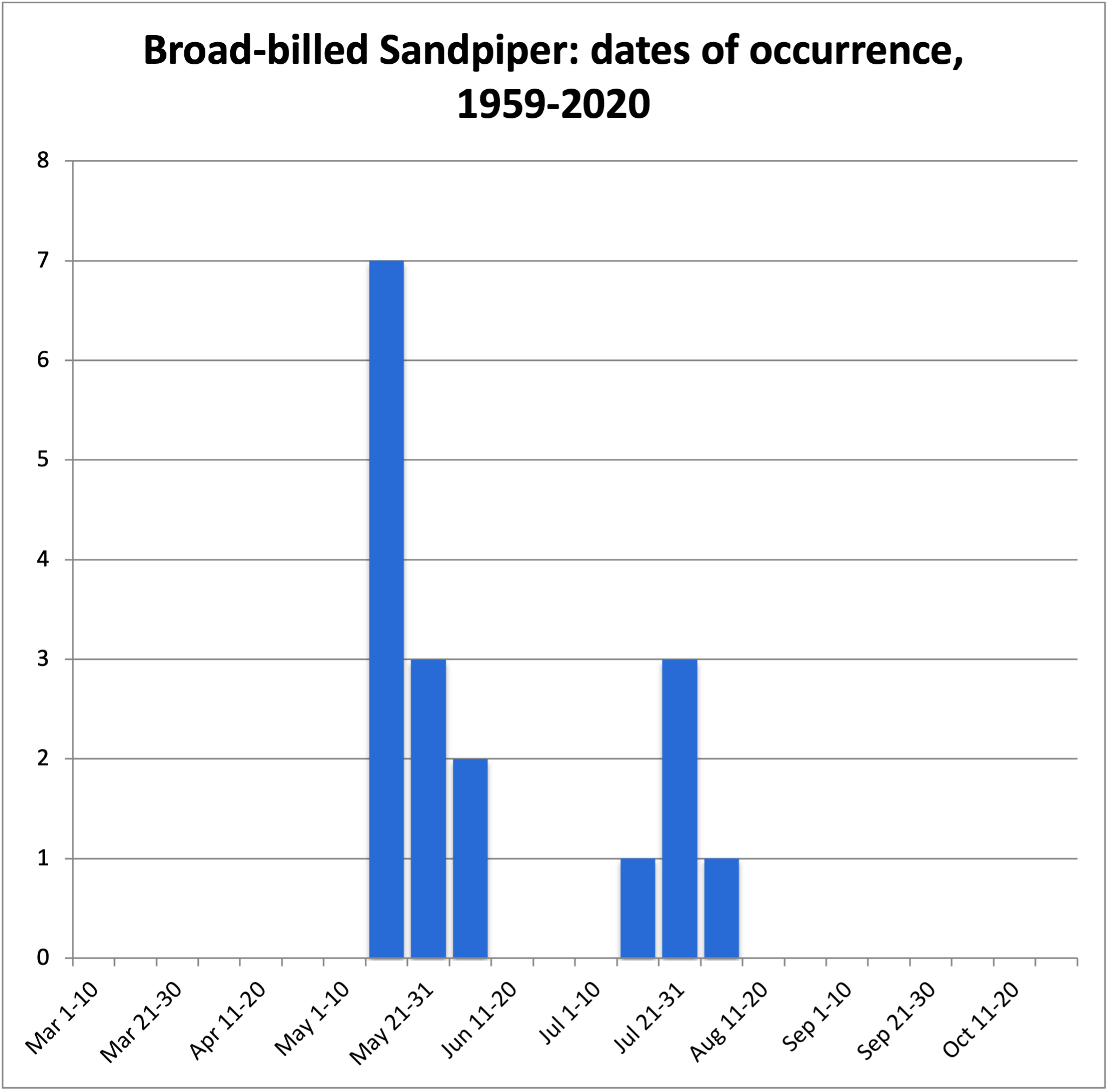Broad-billed Sandpiper Calidris falcinellus



Broad-billed Sandpiper: left, Saltfleetby-Theddlethorpe NNR 26th May 1982 (Keith Atkin) and Frampton Marsh July 2016 (centre, Graham Catley; right, Paul Sullivan)
The first county record was found at Wisbech Sewage Farm in May 1959 and subsequently there have been 16 more. The nominate European race falcinellus breeds in the boreal forest bogs of northern Scandinavia and into Arctic Russia. They migrate through the eastern Mediterranean, Black and Caspian Seas to winter in the Persian Gulf, western India and Sri Lanka, with small numbers in coastal east Africa. Departure from the Fennoscandian breeding grounds, where there are estimated to be some 25,000 breeding pairs (Hagemeijer & Blair, 1997), peaks in July for adults and August for juveniles with a few birds remaining into September. The eastern race sibirica breeds from the Taimyr Peninsula to the Kolyma River delta, and winters from the Bay of Bengal through coastal Southeast Asia to Australia. This race is not known to have occurred in Britain.
Thirteen of the 18 county records occurred in spring, a similar picture to elsewhere in Britain. Of the 10 spring records, the earliest occurred on May 12th and the latest on June 9th. The autumn records (5) were all between July 15th and August 4th. The last autumn date here is rather early compared with the rest of the UK which shows a mid-late September peak with the latest being one on Shetland in early November 1976. More than 250 have been found in Britain to date with more than 70% of those being found in May-Jun, mainly on the east coast. Looking through flocks of Ringed Plovers, Charadrius hiaticula and Dunlins Calidris alpina in spring, as they speed northwards is probably the best way of finding this species.

| Site | First date | Last date | Count | Notes |
| Wisbech STW | 18/05/1959 | 19/05/1959 | 1 | |
| Saltfleetby | 26/05/1982 | - | 1 | |
| Saltfleetby | 19/05/1984 | - | 1 | |
| North Cotes | 29/05/1984 | - | 1 | |
| Gibraltar Point NNR | 26/07/1990 | 27/07/1990 | 1 | Adult or 2CY bird. |
| Read's Island | 06/06/1992 | - | 1 | Adult |
| Skidbrooke North End | 15/07/1995 | 19/07/1995 | 1 | |
| Gibraltar Point NNR | 04/08/1997 | - | 1 | Adult |
| Read's Island/ South Ferriby | 29/05/2000 | 31/05/2000 | 1 | |
| Alkborough Flats | 16/05/2008 | 18/05/2000 | 1 | |
| Alkborough Flats | 16/05/2014 | - | 1 | |
| Gibraltar Point NNR | 29/07/2014 | - | 1 | |
| Gibraltar Point NNR | 14/05/2015 | - | 1 | |
| Frampton Marsh | 09/06/2015 | 12/06/2015 | 1 | |
| Frampton Marsh | 12/05/2016 | 14/05/2016 | 1 | |
| Frampton Marsh | 24/07/2016 | 28/07/2016 | 1 | Presumed different from the May individual. |
| Gibraltar Point | 18/07/2017 | - | 1 | |
| Frampton Marsh | 19/05/2019 | 20/05/2019 | 1 |
Finder’s report: Broad-billed Sandpiper, May 26th, 1982, second county record.
by M. H. Tarrant and B. M. Clarkson.
Note: This account is based on the original BBRC submission by the finder. There were seven records in 1982 bringing the British total since 1950 to 51, with another 15 up to 1949 (before the era of the RC). The first Lincolnshire record in 1959 was duly recorded without ceremony in the RC for that year and in the LNU Transactions XV(I), p56 and 75; there is nothing on file for that record.
Circumstances
The recent high tides had reached the edge of the developing dune formation, leaving pools of water along the mud and sand-flats. Whilst photographing the migrant Dunlin and Sanderling on the flats, this bird unexpectedly appeared in the viewfinder of my camera. The bird remained in the area for much of the rest of the day and could be located feeding on the perimeter of the migrant wader flock present. It was very approachable. It’s feeding technique was quite different from all the other waders present in that it used a sweeping motion from side to side, probing with bill tip in a deliberate manner, before running on a few steps at a time. Flight generally erratic as in the manner of a Common Snipe Gallinago gallinago.
The bird was watched for a total of 2 hr. 40 min. in three sessions between 10.25 and 18.10 hr. using Zeiss 10x40B dialyt binoculars and a Bausch & Lomb Discoverer 15-60x60 telescope. The wind was southerly, force 1 building to force 3 by the end of the day. Cloud 30%, increasing to 65% cover. Cloud brought overnight rain and wind veered northerly.
Description
General - noticeably smaller than Dunlin present, both in height and length. Legs very short giving the bird a somewhat squat posture and fairly horizontal stance. Bill disproportionately long. Upper mandible broad with tip sharply downward-pointing and looking flat with head-on view. Bill otherwise straight. Tail covered
At rest by primary tips which projected just beyond. Darker than other waders present and giving the initial impression of being black above and white below. A closer inspection showed the upperparts to be black to black-brown with contrasting white edges and markings, especially on the head. Underparts white with blackish-brown streaks and bars.
Head - broad, black crown stripe standing out against white lateral crown stripes. Broad, white supercilium extending to rear of crown, striking, standing out against black borders. On the forehead, the lateral crown stripe and the supercilium merged to give a forked appearance. A thick black line on side of the crown to the rear separated the two creamy-white stripes; double supercilium showed more yellow towards the edges than any other feathers which were pale-edged. Lores and ear coverts streaked dark brown with some buff. Black eye stripe running from bill to eye and from rear of eye to mid-ear covert. Side of neck to nape paler than back or crown, and streaked grey-brown. Black-brown streak down centre of nape.
Upperparts – feathers of back blackish, edged orange-russet. Greater, median, and lesser coverts broadly edged creamy-white with blackish-brown centres. Scapulars had thinner creamy-white edgings with blackish-brown centres. Edges of braces and scapulars more yellow-looking than coverts. Primaries and secondaries blackish-brown, thinly edged whitish. Rump blackish, tail centre showed a thick black line to tail end. Lateral outer tail broad white from base. End of outer tail grey, looking paler grey when fanned.
In flight, back was darker than the browner-looking wings. All feathers clearly edged whitish with a very thin wing-bar across the greater coverts tips. When flying away the bird sometimes appeared to show no wing bar at all. Bases of inner web of remiges showed white edges when wing was fully extended showing more of the wing bar.
Underparts - white, striking against the upperparts. Chin whitish, throat, upper breast, sides of breast all streaked blackish-brown, with brownish-grey smudging. Some black-brown between breast and throat. Streaks of blackish-brown continues along flanks towards undertail coverts.
Bare parts – bill blackish-brown, nearly twice the length of the head. Legs grey and length equal to body depth. Eyes dark.
Call – phonetically “truick”, “treek” or “chrrk”. A single note heard several times as it flew away.
Reference
Hagemeijer, E.J.M. and M.J. Blair (editors). 1997. The EBCC Atlas of European Breeding Birds: their distribution and abundance. T & A.D. Poyser, London.

